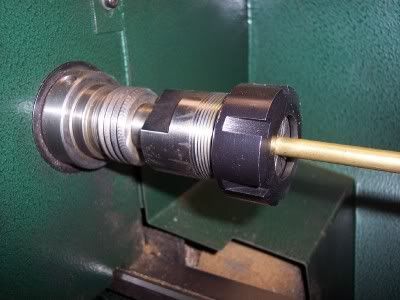There seems to be a huge amount of confusion across all the web forums and email lists related to work holding collets and tool holding collets. This reply I'm quoting here is a good example.
While the ER collets are suitable for both work and tool holding, the method shown here to adapt the collet to the spindle is not suitable for lathe work. This adapter is meant to be used in a milling machine.
A work holding collet will have a couple of features important to use on a lathe. It will be self releasing, or in the case of the ER collets drawn out by the nut, and it will also have an open bore.
The R8 collet for example has neither of these features. Using an R8 collet (or MT taper collet) will limit the length of work to only a few inches because the collets have a blind hole. You'll also have to drive the collet out of the spindle taper after each use. Hammering on the end of your spindle is not a kind thing to do to it.
My own opinion on collets for lathe use is to stick with the 5C style. If your spindle is large enough to run an adapter to go from MT5 (or whatever you spindle taper is) to 5C, then buy or make the adapter and draw tube (note: I sad "tube" and not bar). If it doesn't then get a 5C chuck with an adjustable backing plate. Dial in the taper on the 5C chuck and your all set.
The one advantage to the ER collets is the ability to share them between mills and lathe, but they are no where near a versatile as 5C collets. With 5C you have the option of round, square and hex collets. There are also pot/step collets and E collets that can make life much more enjoyable.
Two things to consider with the pot and e collets that's useful in engine building. You can take a 2" or 3" pot collet and bolt sacrificial jaws on it then cut any size step into them, concentric or offset. Ditto on the e collet. You could take a soft steel e collet and broach a 1/2' square hole, offset by .110 for drilling an offset through hole in 10 parts. Now you could use a 4 jaw to do the same thing, but it would be a pain by comparison.
Lastly, there is no "need" for most of us to have a complete set of 5C collets in 16ths, 32nds and 64ths. Most will never be used and even with import collets, a complete set is a large investment. I recommend a complete set of 16ths, a 3" step and a few E collets to start with. A person can add others as needed.
rake60 said:
The problem with adapters is they add to the extended length from the spindle.
That extra length robs rigidity.
The Import 9 X 20 Lathes have an MT3 taper in the spindle.
I bought an ER32 collet holder for mine because I already owned an R8-ER32
collet holder for my mini-mill along with a full set of collets.
It didn't impress me. It looks like this in the lathe.
And, it is as rigid as it appears. :

Rick






